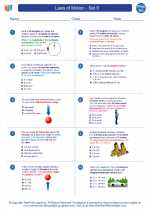Weather Patterns Explanation
Weather patterns refer to the recurring or predictable changes in weather conditions over a particular area. These patterns are influenced by a variety of factors including the Earth's rotation, atmospheric pressure, temperature, humidity, and the distribution of land and water across the globe.
Understanding weather patterns is crucial for predicting and preparing for different weather events such as storms, heatwaves, and cold fronts. Meteorologists use various tools and techniques to analyze and forecast these patterns, providing valuable information for agriculture, transportation, and disaster management.
Factors Influencing Weather Patterns
- Atmospheric Pressure: Variations in atmospheric pressure lead to the formation of high and low-pressure systems, which in turn influence wind patterns and weather conditions.
- Temperature: Variations in temperature create differences in air density, leading to the movement of air masses and the formation of weather systems.
- Humidity: The amount of moisture in the air affects the formation of clouds, precipitation, and the intensity of weather events.
- Wind Patterns: The Earth's rotation and the distribution of land and water create global wind patterns, such as the trade winds and westerlies, which impact weather conditions.
- Ocean Currents: Ocean currents influence the transfer of heat energy between the ocean and the atmosphere, affecting regional climate and weather patterns.
Types of Weather Patterns
Weather patterns can manifest in various forms, each with distinct characteristics and effects. Some common types of weather patterns include:
- Cyclones and Anticyclones: These large-scale systems involve the movement of air around centers of low or high pressure, leading to distinct weather conditions such as storms or fair weather.
- Fronts: Frontal boundaries between air masses of different temperatures can trigger changes in weather, resulting in phenomena like thunderstorms, rain, or snow.
- Monsoons: Seasonal wind patterns that bring heavy rainfall to certain regions during specific times of the year, impacting agriculture and water resources.
- El Niño and La Niña: These climate phenomena, associated with variations in sea surface temperatures in the Pacific Ocean, can cause widespread changes in weather patterns globally.
Weather Patterns Study Guide
Key Concepts to Understand
- Understanding the relationship between atmospheric pressure and weather systems.
- Identifying the influence of temperature differentials on the formation of weather patterns.
- Explaining the role of humidity in cloud formation and precipitation.
- Analyzing the impact of global wind patterns on regional weather conditions.
- Recognizing the significance of ocean currents in shaping local climate and weather patterns.
Tools and Techniques for Studying Weather Patterns
- Weather instruments such as barometers, thermometers, and hygrometers for measuring atmospheric conditions.
- Satellite imagery and radar technology for tracking cloud formations, storm systems, and atmospheric disturbances.
- Computer models and simulations for predicting and analyzing weather patterns based on complex meteorological data.
Application and Impact of Weather Patterns
- How weather patterns influence agricultural practices, crop yields, and water management strategies.
- The role of weather patterns in shaping regional climate variations and extreme weather events.
- The significance of understanding weather patterns for aviation, maritime operations, and disaster preparedness.
- The global impact of phenomena like El Niño and La Niña on weather patterns, ecosystems, and human societies.
Practical Exercises and Observations
- Conducting weather observations and recording data to track changes in atmospheric conditions over time.
- Analyzing historical weather data to identify recurring patterns and trends in a specific region.
- Studying the effects of weather patterns on local ecosystems, including plant growth, animal behavior, and water cycles.
- Engaging in hands-on experiments to simulate and understand the formation of weather phenomena such as thunderstorms or cyclones.
By mastering the concepts, tools, and real-world implications of weather patterns, students can gain a comprehensive understanding of this fundamental aspect of Earth's dynamic atmosphere.
.◂Physics Worksheets and Study Guides High School. Laws of Motion - Set II

 Worksheet/Answer key
Worksheet/Answer key
 Worksheet/Answer key
Worksheet/Answer key
